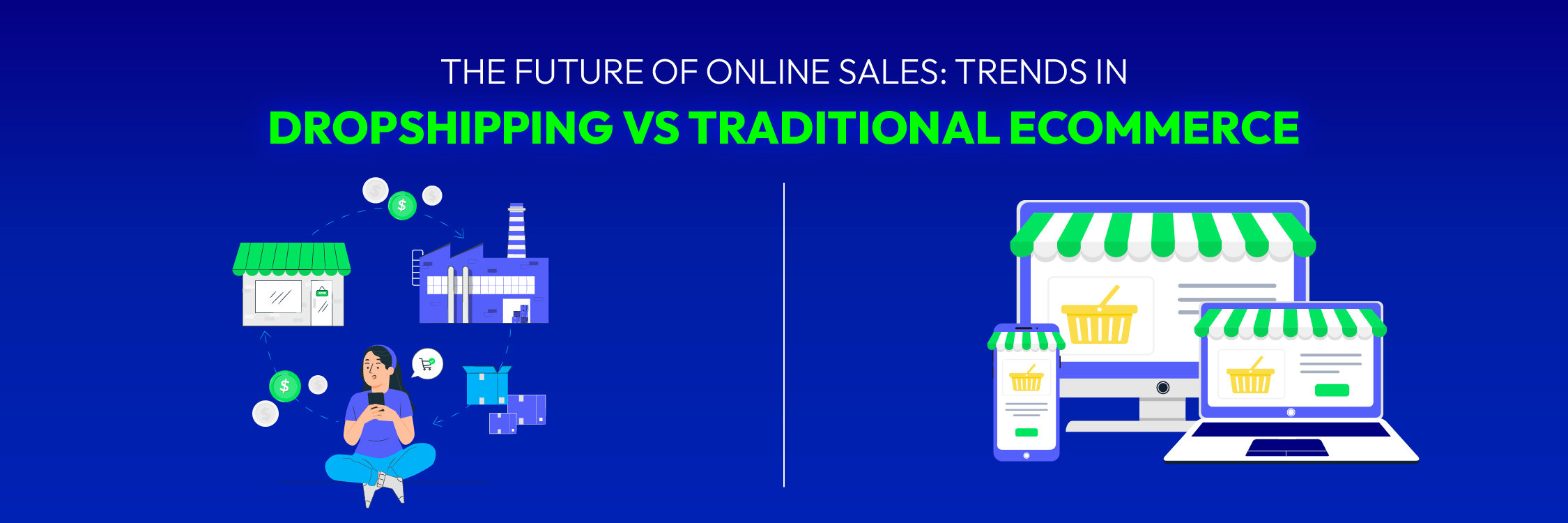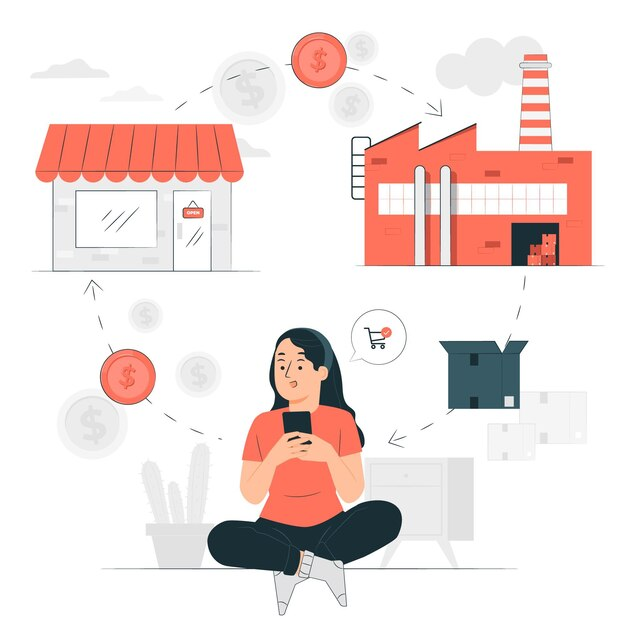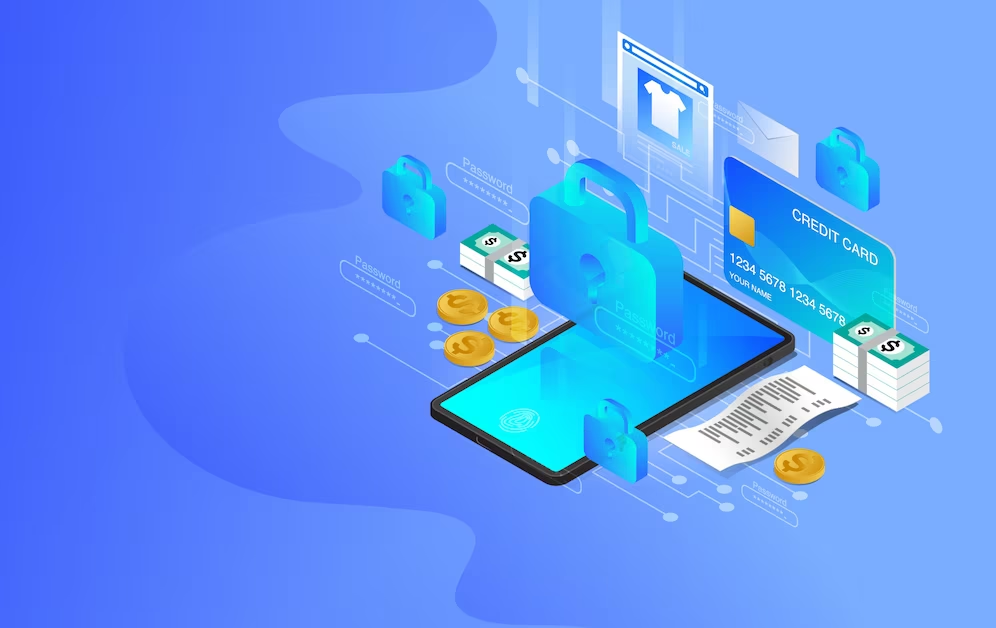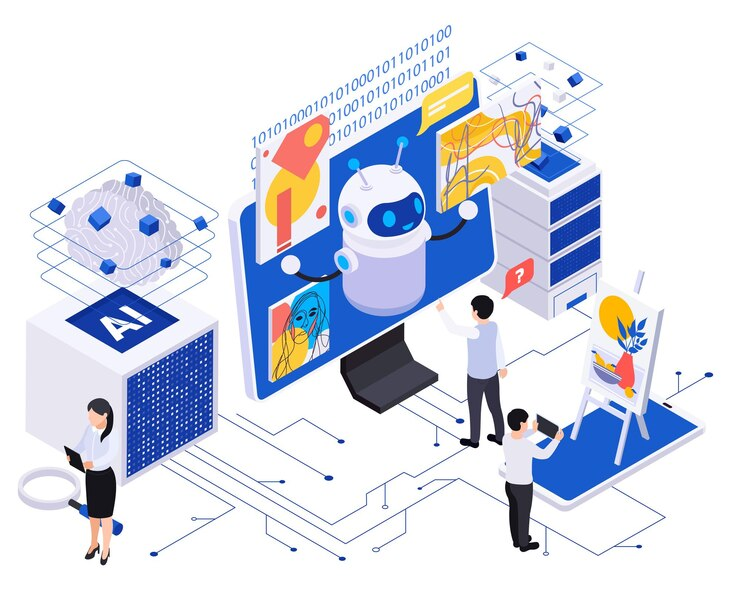The Future of Online Sales: Trends in Dropshipping vs Traditional eCommerce

Two prominent models, dropshipping and traditional eCommerce, have significantly shaped the way businesses engage in digital retail. Both methodologies offer distinct approaches, each with its advantages and challenges.
This comprehensive analysis explores the nuances, advantages, and limitations of both models, shedding light on their operational mechanisms, emerging trends, and predictions for the future.
By dissecting the fundamental differences, similarities, and impact of emerging technologies and consumer behaviors, this article aims to provide a holistic understanding of the evolving landscape of online sales in the realm of dropshipping and traditional eCommerce.
Overviews of Dropshipping and Traditional eCommerce
Dropshipping eCommerce
Definitions
Dropshipping is a business model within eCommerce where an online retailer (the dropshipper) doesn’t keep the products it sells in stock. Instead, when a customer makes a purchase, the retailer purchases the item from a third-party supplier (usually a wholesaler or manufacturer) and has it shipped directly to the customer. The retailer never physically handles the product, as it is shipped directly from the supplier to the customer. Read more: Shopify Dropshipping for Beginners: 15 Important Steps to Start

Advantages
-
Low Startup Costs: Dropshipping requires minimal initial investment as there’s no need to purchase inventory upfront. This makes it an attractive option for entrepreneurs starting an online business with limited capital.
-
Reduced Overhead: As there’s no need for warehousing or managing inventory, operational costs such as storage space, inventory management, and associated expenses are significantly lower.
-
Flexibility and Scalability: Dropshipping allows for greater flexibility in testing and adding new products to the store without the risk of unsold inventory. It also offers scalability since the business can handle increased sales without major logistical changes.
-
Wide Product Selection: Dropshippers can offer a wide range of products without physically stocking them, enabling the exploration of different niches and product categories.
-
Location Independence: As the business operates online, it can be managed from anywhere with an internet connection, providing flexibility in work location.
Disadvantages
-
Lower Profit Margins: Due to buying products at wholesale prices, dropshippers typically have lower profit margins compared to traditional retailers who buy in bulk at lower rates.
-
Quality Control Challenges: Since the dropshipper doesn’t handle the products, ensuring product quality, accurate inventory levels, and timely shipping can be challenging.
-
Dependency on Suppliers: The success of a dropshipping business relies heavily on the reliability and efficiency of the suppliers. Any issues with product availability, shipping delays, or quality can directly impact customer satisfaction.
-
Shipping Complexities: Coordinating shipping from multiple suppliers can lead to fragmented delivery schedules, potentially resulting in longer shipping times and multiple shipping fees for customers ordering multiple products from different suppliers.
-
High Competition: The ease of entry into dropshipping leads to increased competition, making it challenging to stand out unless the business offers unique value propositions or exceptional customer service.
Traditional eCommerce
Definitions
Traditional eCommerce refers to the conventional model of online retailing where businesses purchase and maintain their inventory, manage storage facilities, handle order fulfillment, and ship products directly to customers. In this model, retailers have full control over their inventory, allowing them to manage product quality, shipping times, and customer service directly.
Advantages
-
Control Over Inventory: Retailers have direct control over the inventory, enabling them to maintain product quality standards and manage stock levels efficiently.
-
Brand Control: Businesses can establish and promote their brand identity, ensuring consistency in product presentation and customer experience.
-
Higher Profit Margins: Retailers can potentially achieve higher profit margins by purchasing products in bulk at lower prices and setting their retail prices accordingly.
-
Customization and Flexibility: With control over inventory, retailers can customize packaging, promotions, and customer experiences to a higher degree.
-
Quality Control: Direct handling of inventory allows businesses to oversee product quality, reducing the risk of shipping errors or damaged goods.
Disadvantages
-
High Initial Investment: Requires significant upfront capital for inventory procurement, storage facilities, and operational costs, which may be a barrier for small businesses or startups.
-
Inventory Management Challenges: Risk of overstocking or understocking items, leading to potential losses due to unsold inventory or missed sales opportunities.
-
Operational Complexity: Managing warehouse logistics, order fulfillment, and shipping processes can be operationally challenging and resource-intensive.
-
Risk of Unsold Inventory: In traditional eCommerce, retailers bear the risk of inventory that may become obsolete or unsellable, leading to potential losses.
-
Limited Scalability: Expansion may require substantial investment in infrastructure, and scaling operations can be slower compared to dropshipping due to logistical complexities.
Comparative Analysis: Dropshipping and Traditional eCommerce
Similarities between Dropshipping and Traditional eCommerce
Online Presence
Both models operate within the digital realm, utilizing online platforms like websites or digital marketplaces to sell products to customers.
Customer Focus
Both models prioritize providing a positive customer experience, aiming to meet customer needs and preferences through their product offerings and services.
Payment Processing
Both models involve handling online payments. They utilize similar payment gateways, processing methods, and security measures to facilitate transactions between customers and the business.

Digital Marketing Strategies
Both models rely on digital marketing techniques to attract customers, drive traffic to their online platforms, and increase sales. This includes tactics such as SEO, social media marketing, email marketing, and PPC advertising.

Marketing Solution for Magento 2
Effectively attract customers to visit your store, especially necessary for the holiday shopping season.
Check it out!Legal and Regulatory Compliance
Both models must adhere to legal and regulatory requirements related to eCommerce, such as consumer protection laws, data privacy regulations, taxation, and any industry-specific regulations that apply.
Focus on Profitability
Ultimately, both models aim to generate revenue and profitability, albeit through different operational approaches. They both strive to maximize sales, minimize costs, and optimize their business strategies to increase profitability.
Customer Service Importance:
Difference between Dropshipping and Traditional eCommerce
Inventory Management
-
Dropshipping: Involves no inventory holding. Products are directly shipped from suppliers to customers upon purchase.
-
Traditional eCommerce: Retailers manage their inventory, storing products in warehouses and shipping them to customers upon purchase.
Upfront Investment
-
Dropshipping: Requires minimal upfront investment since there’s no need to purchase and store inventory beforehand.
-
Traditional eCommerce: Involves significant initial investment in inventory procurement, storage, and management.
Control Over Product Quality and Fulfillment
-
Dropshipping: Quality control and order fulfillment are managed by third-party suppliers. This may lead to inconsistencies in product quality and shipping times.
-
Traditional eCommerce: Retailers have direct control over product quality, packaging, and shipping speed, ensuring a more hands-on approach to customer satisfaction.
Profit Margins
-
Dropshipping: Typically offers lower profit margins due to buying products at wholesale prices from suppliers.
-
Traditional eCommerce: Often allows for higher profit margins as retailers can set their prices based on the cost of goods and negotiate bulk discounts with suppliers.
Scalability and Flexibility
-
Dropshipping: Offers flexibility in quickly adding or removing products without inventory risk, but may face scalability challenges in maintaining quality control and supplier relationships with increased sales volume.
-
Traditional eCommerce: Can be more scalable in the long run as businesses have control over logistics and can optimize margins with increased sales volume.
Supplier Relationships
-
Dropshipping: Relies heavily on establishing and maintaining strong relationships with suppliers for product sourcing and fulfillment.
-
Traditional eCommerce: Retailers procure products directly from manufacturers or wholesalers, maintaining direct relationships and potentially negotiating better terms.
Operational Complexity
-
Dropshipping: Simplifies operations by outsourcing inventory management and fulfillment but introduces complexities in managing multiple suppliers and ensuring consistent quality and delivery.
-
Traditional eCommerce: Involves more complex logistics and inventory management, requiring investment in warehouse facilities, staff, and inventory control systems.
| Aspect | Dropshipping eCommerce | Traditional eCommerce |
|---|---|---|
| Inventory Management | No inventory handling | Retailer manages inventory |
| Initial Investment | Low upfront investment | Significant initial investment |
| Quality Control | Managed by suppliers | Controlled by the retailer |
| Profit Margins | Generally lower | Potential for higher margins |
| Scalability | Flexible, but challenges at scale | More scalable in many instances |
| Supplier Relationships | Reliance on strong supplier ties | Direct procurement relationships |
| Operational Complexity | Simplified operations | More complex logistics |
Emerging Trends in Dropping and Traditional eCommerce
Emerging Trends in Dropshipping
Technology Integration
-
AI and Automation: Increased use of AI-driven tools for product selection, customer service, and marketing optimization.
-
Data Analytics: Utilizing data-driven insights to improve decision-making and personalize customer experiences.
Supplier Relations
-
Collaborative Partnerships: Building stronger relationships with suppliers to ensure quality, faster shipping, and better inventory management.
-
Diversification: Exploring multiple suppliers or sources for product diversification and risk mitigation.

Niche Markets
- Specialized Stores: Focusing on niche markets and specific customer segments to cater to unique demands and preferences.
Sustainability
- Eco-friendly Practices: Implementing eco-conscious initiatives such as sustainable packaging, carbon-neutral shipping, and ethical sourcing.
Customer-Centric Approach
- Personalization: Leveraging customer data to offer personalized recommendations and experiences, enhancing customer engagement and loyalty.
Cross-border Dropshipping
- Global Expansion: Expanding into international markets through cross-border dropshipping, leveraging the reach of suppliers in different regions.
Dropshipping Platforms
- Advanced Tools: Development of more sophisticated dropshipping platforms offering better integration, analytics, and streamlined processes for sellers.
Shorter Delivery Times
- Faster Shipping Options: Exploring partnerships or strategies to reduce delivery times, meeting the growing demand for quicker shipping.
Emerging Trends in Traditional eCommerce
Omnichannel Retailing
- Integration of Online and Offline: Blending physical and digital retail experiences to provide a seamless shopping journey for customers. Offering click-and-collect, in-store pickups for online orders, etc.
Direct-to-Consumer (D2C) Approach
- Bypassing Intermediaries: Brands selling directly to consumers without intermediaries, establishing direct connections to build brand loyalty, and control over the customer experience.
Read more: Magento 2 for direct-to-consumer (D2C) manufacturers
Localized Warehousing
- Faster Shipping Through Proximity: Adoption of localized warehousing to reduce shipping times and costs, ensuring quicker deliveries to customers.
Sustainability Initiatives
- Eco-conscious Practices: Embracing sustainability in packaging, logistics, and operations. Utilizing eco-friendly packaging, reducing carbon footprints, and ensuring ethical sourcing.
Enhanced Customer Experiences
- Personalization and Customization: Leveraging data analytics to offer personalized recommendations and customized shopping experiences for customers.
Technology Integration
- AI and Automation: Implementation of AI-driven tools for inventory management, predictive analytics, chatbots for customer service, and enhancing operational efficiency.
Mobile Commerce Optimization
- Mobile-Friendly Strategies: Prioritizing mobile commerce optimization, ensuring seamless shopping experiences on mobile devices, and investing in mobile apps for enhanced customer engagement.
Social Commerce and Influencer Marketing
- Utilization of Social Platforms: Leveraging social media for direct selling, integrating shopping features, and utilizing influencer marketing to reach and engage with audiences.

FREE Social Share for Magento 2
Add multiple social sharing buttons on store sites, drive organic traffic, and expand your online presence
Check it out!Subscription-based Models
- Subscription Services: Introduction of subscription-based models to offer convenience, curated experiences, and recurring revenue streams for businesses.
| Emerging Trends | Dropshipping | Traditional eCommerce |
|---|---|---|
| Technology Integration | AI, Automation, Data Analytics | AI, Automation, Data Analytics |
| Supplier Relations | Strong partnerships, Diversification | Strategic partnerships, Localization |
| Niche Markets | Specialized stores, Targeting niches | Targeting niche segments, D2C Approach |
| Sustainability | Eco-friendly practices | Sustainable packaging, Eco-consciousness |
| Customer-Centric Focus | Personalization, Enhanced support | Personalization, Enhanced experiences |
| Global Expansion | Cross-border operations | Global reach, Localized Warehousing |
| Advanced Platforms | Streamlined dropshipping platforms | Advanced technological integration |
| Delivery Optimization | Faster shipping solutions | Faster shipping, Mobile optimization |
Predictions for the Future
Potential Shifts in Consumer Behavior
-
Impact on Dropshipping: Consumers may prioritize convenience over brand loyalty, driving the need for faster shipping and hassle-free experiences. Dropshipping might benefit due to its agility in testing and adapting to changing demands.
-
Impact on Traditional eCommerce: Customers seeking brand trust and consistency might still prefer traditional eCommerce for direct control over product quality and service.
Role of Emerging Technologies
- AI, VR, and AR: Expected to significantly enhance customer experiences in both models by providing personalized recommendations, immersive shopping, and virtual try-ons. They will reshape how consumers interact with products online.
Geopolitical and Logistic Challenges
- Supply Chain Disruptions: Geopolitical tensions or environmental concerns could disrupt global supply chains. Businesses must diversify suppliers and invest in resilient logistics to navigate uncertainties.

How Retailers Can Prepare for the Future
Retailers can prepare for the future by adopting proactive strategies that align with emerging trends, technological advancements, and changing consumer behaviors in the eCommerce landscape. Here are key ways retailers can prepare for the future:
Diversifying Sales Strategies
-
Hybrid Models: Explore a combination of dropshipping and holding inventory strategically for a more versatile approach that balances convenience and control over product quality.
-
Omnichannel Retailing: Invest in strategies that seamlessly integrate online and offline sales channels to provide a unified shopping experience for customers.
Investing in Technology and Innovation
-
AI Integration: Implement AI-driven analytics to gather insights, predict trends, personalize customer experiences, and optimize inventory management.
-
Enhanced Customer Experience: Embrace emerging technologies like AR/VR to offer immersive shopping experiences, virtual try-ons, and interactive product showcases.

Building Strong Supplier and Customer Relationships
-
Supplier Partnerships: Foster strong relationships with reliable suppliers to ensure consistent product quality, faster shipping, and better inventory management.
-
Customer-Centric Approach: Prioritize customer satisfaction by offering excellent service, personalized experiences, and addressing sustainability concerns to align with evolving consumer values.
Adaptability and Resilience
-
Supply Chain Flexibility: Prepare for potential disruptions by diversifying suppliers and adopting resilient logistics to mitigate geopolitical or logistic challenges.
-
Agility in Business Operations: Stay adaptable and responsive to market changes, consumer preferences, and technological advancements.
Sustainability Initiatives
-
Eco-Friendly Practices: Embrace sustainable practices in packaging, shipping, and sourcing to appeal to environmentally conscious consumers.
-
Corporate Social Responsibility: Demonstrate commitment to social and environmental causes, which can positively impact brand perception and customer loyalty.
Conclusion
The predictive analysis indicates a future where both models will coexist, catering to varying consumer preferences and market demands. While dropshipping offers agility, lower entry barriers, and a wide product range, traditional eCommerce provides greater control, higher profit margins, and a focus on brand identity and product quality. By staying informed, adaptable, and aligning their strategies with emerging trends, businesses in both dropshipping and traditional eCommerce can navigate the challenges and opportunities presented in the dynamic world of online sales.





![Top 20+ Must-have Shopify Apps for 2025 [Free & Paid] - Mageplaza](https://cdn2.mageplaza.com/media/blog/must-have-shopify-apps/top-must-have-shopify-apps.png)
![[2025 Updates] Top 10+ Upsell Apps for Shopify - Mageplaza](https://cdn2.mageplaza.com/media/blog/best-upsell-shopify-app/cover.png)